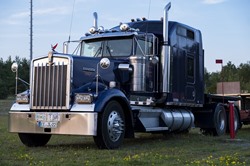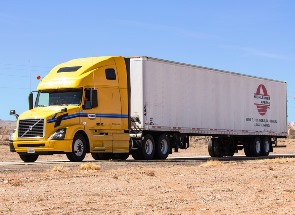How to Enroll in the Right Truck Driving Classes near Lakota Iowa
 Congrats on your decision to become a trucker and enroll in a truck driving school near Lakota IA. Maybe it has always been your ambition to hit the open road while driving a monster tractor trailer. Or possibly you have done some analysis and have found that an occupation as a truck driver offers excellent pay and flexible work opportunities. No matter what your reason is, it’s imperative to receive the appropriate training by choosing the right CDL school in your area. When reviewing your options, there are various variables that you’ll need to think about before making your final selection. Location will certainly be an issue, particularly if you need to commute from your Lakota residence. The cost will also be of importance, but selecting a school based solely on price is not the optimal method to guarantee you’ll obtain the appropriate training. Just remember, your goal is to master the knowledge and skills that will enable you to pass the CDL exams and become a qualified truck driver. So keeping that purpose in mind, just how do you decide on a truck driving school? The answer to that question is what we are going to cover in the rest of this article. But first, we are going to discuss a little bit about which commercial driver’s license you will ultimately need.
Congrats on your decision to become a trucker and enroll in a truck driving school near Lakota IA. Maybe it has always been your ambition to hit the open road while driving a monster tractor trailer. Or possibly you have done some analysis and have found that an occupation as a truck driver offers excellent pay and flexible work opportunities. No matter what your reason is, it’s imperative to receive the appropriate training by choosing the right CDL school in your area. When reviewing your options, there are various variables that you’ll need to think about before making your final selection. Location will certainly be an issue, particularly if you need to commute from your Lakota residence. The cost will also be of importance, but selecting a school based solely on price is not the optimal method to guarantee you’ll obtain the appropriate training. Just remember, your goal is to master the knowledge and skills that will enable you to pass the CDL exams and become a qualified truck driver. So keeping that purpose in mind, just how do you decide on a truck driving school? The answer to that question is what we are going to cover in the rest of this article. But first, we are going to discuss a little bit about which commercial driver’s license you will ultimately need.
Which Commercial Drivers License Will You Require?
 In order to operate commercial vehicles legally within the USA and Lakota IA, an operator must attain a CDL (Commercial Driver’s License). The 3 license classes that one can qualify for are Class A, Class B and Class C. Since the subject of this article is how to pick a truck driver school, we will address Class A and Class B licenses. What differentiates each class of CDL is the kind of vehicle that the driver can operate together with the GVWR (Gross Vehicle Weight Rating) or GCWR (Gross Combination Weight Rating). Following are short summaries for the two classes.
In order to operate commercial vehicles legally within the USA and Lakota IA, an operator must attain a CDL (Commercial Driver’s License). The 3 license classes that one can qualify for are Class A, Class B and Class C. Since the subject of this article is how to pick a truck driver school, we will address Class A and Class B licenses. What differentiates each class of CDL is the kind of vehicle that the driver can operate together with the GVWR (Gross Vehicle Weight Rating) or GCWR (Gross Combination Weight Rating). Following are short summaries for the two classes.
Class A CDL. A Class A CDL is needed to operate any vehicle that has a GCWR of more than 26,000 lbs., including a towed vehicle of greater than 10,000 lbs. Some of the vehicles that operators may be able to drive with Class A licenses are:
- Interstate or Intrastate Tractor Trailers
- Trucks with Double or Triple Trailers
- Tanker Trucks
- Livestock Carriers
- Class B and Class C Vehicles
Class B CDL. A Class B CDL is needed to operate single vehicles having a GVWR of more than 26,000 lbs., or a GCWR of greater than 26,000 lbs. including a towed vehicle weighing up to 10,000 lbs. A few of the vehicles that drivers may be qualified to operate with Class B licenses are:
- Tractor Trailers
- Dump Trucks
- Cement Mixers
- Large Buses
- Class C Vehicles
Both Class A and Class B Commercial Drivers Licenses might also require endorsements to drive specific kinds of vehicles, including school or passenger buses. And a Class A licensee, with the proper needed endorsements, may operate any vehicle that a Class B licensee is qualified to drive.
Click Here to Get Free Information on Truck Driving Schools Near You!
How to Evaluate a Trucking School
 After you have determined which CDL you would like to pursue, you can begin the process of evaluating the Lakota IA trucking schools that you are considering. As previously discussed, cost and location will no doubt be your primary considerations. But it can’t be emphasized enough that they must not be your only considerations. Other factors, for example the reputations of the schools or the experience of the instructors are similarly or even more important. So below are a few additional things that you should research while conducting your due diligence prior to selecting, and particularly paying for, your truck driving training.
After you have determined which CDL you would like to pursue, you can begin the process of evaluating the Lakota IA trucking schools that you are considering. As previously discussed, cost and location will no doubt be your primary considerations. But it can’t be emphasized enough that they must not be your only considerations. Other factors, for example the reputations of the schools or the experience of the instructors are similarly or even more important. So below are a few additional things that you should research while conducting your due diligence prior to selecting, and particularly paying for, your truck driving training.
Are the Schools Certified or Accredited ? Not many trucking schools in the Lakota IA area are accredited due to the demanding process and expense to the schools. However, certification is more prevalent and is offered by the Professional Truck Driver Institute (PTDI). A school is not obligated to become certified, but there are certain advantages. Interested students recognize that the training will be of the highest standard, and that they will be given lots of driving time. For example, PTDI calls for 44 hours of actual driving time, not ride-alongs or simulations. So if a school’s course is certified (the course, not the school is certified), students know that the training and curriculum will meet the very high benchmarks set by PTDI.
How Long in Operation? One clue to help assess the quality of a trucking school is how long it has been in operation. A negatively rated or a fly by night school normally will not stay in business very long, so longevity is a plus. On the other hand, even the top Lakota IA schools had to begin from their first day of training, so use it as one of multiple qualifications. You can also ask what the school’s history is relating to successful licensing and job placement of its graduates. If a school won’t supply those stats, search elsewhere. The schools should also have relationships with local and national trucking companies. Having a large number of contacts not only points to a superior reputation within the trade, but also boosts their job assistance program for graduates. It also wouldn’t hurt to contact the Iowa licensing authority to verify that the CDL trucking schools you are reviewing are in good standing.
How Good is the Training? As a minimum requirement, the schools must be licensed in Iowa and hire instructors that are experienced and trained. We will talk more about the instructors in the following segment. Also, the student to instructor proportion should not be higher than 4 to 1. If it’s any higher, then students will not be receiving the individual attention they will need. This is especially true regarding the one-on-one instruction for behind the wheel training. And be critical of any school that professes it can teach you to drive trucks in a comparatively short period of time. Learning to be a truck driver and to drive a tractor trailer skillfully takes time. The majority of Lakota IA schools offer training courses that run from 3 weeks to as long as two months, depending on the license class or kind of vehicle.
How Experienced are the Instructors? As earlier stated, it’s essential that the instructors are trained to teach driving methods and experienced as both instructors and drivers. Although several states have minimum driving time criteria to be certified as an instructor, the more successful driving experience an instructor has the better. It’s also important that the teachers stay current with industry developments or any new laws or changes in regulations. Evaluating instructors may be a little more subjective than other standards, and possibly the best method is to pay a visit to the school and talk to the instructors in person. You can also speak with some of the students going through the training and ask if they are happy with the quality of instruction and the teacher’s ability to train them.
How Much Driving Time? Above all else, a great truck driving school will furnish ample driving time to its students. After all, isn’t that what it’s all about? Driving time is the real time spent behind the wheel operating a truck. Even though the use of simulators and ride-a-longs with other students are necessary training methods, they are no substitute for real driving. The more training that a student gets behind the wheel, the better driver she or he will become. Although driving time can vary between schools, a good standard is a minimum of 32 hours. If the school is PTDI certified, it will provide a minimum of 44 hours of driving time. Check with the Lakota IA schools you are looking at and ask how much driving time they furnish.
Are they Captive or Independent ? You can obtain discounted or even free training from some truck driver schools if you enter into an agreement to be a driver for a specific carrier for a defined time period. This is what’s known as contract training, and the schools that offer it are called captives. So rather than maintaining relationships with numerous trucking lines that they can place their graduates with, captives only work with one company. The tradeoff is receiving free or less expensive training by giving up the freedom to initially be a driver wherever you choose. Naturally contract training has the potential to restrict your income opportunities when beginning your new career. But for some it may be the only way to get affordable training. Just make sure to inquire if the Lakota IA schools you are looking at are independent or captive so that you can make an informed decision.
Is there Onsite CDL Testing? There are several states that will permit third party CDL testing onsite of truck driving schools for its grads. If onsite testing is permitted in Iowa, ask if the schools you are reviewing are DMV certified to offer it. One benefit is that it is more accommodating than competing with graduates from competing schools for test times at Iowa testing locations. It is also an indicator that the DMV views the approved schools to be of a superior quality.
Are the Class Times Flexible? As formerly mentioned, CDL training is just 1 to 2 months long. With such a brief duration, it’s essential that the Lakota IA school you enroll in offers flexibility for both the scheduling of classes and the curriculum. For example, if you’re having a hard time learning a particular driving maneuver, then the instructor should be prepared to spend more time with you until you are proficient. And if you’re still employed while going to training, then the class scheduling needs to be flexible enough to fit in working hours or other commitments.
Is Job Placement Provided? As soon as you have acquired your commercial driver’s license after graduating from truck driving school, you will be anxious to start your new profession. Confirm that the schools you are contemplating have job assistance programs. Find out what their job placement rate is and what average salary their grads start at. Also, find out which local and national trucking firms their graduates are referred to for hiring. If a school has a lower job placement rate or not many Lakota IA employers recruiting their grads, it may be a clue to look elsewhere.
Is Financial Aid Provided? Truck driving schools are comparable to colleges and other Lakota IA area trade or technical schools when it comes to loans and other forms of financial aid being offered. Find out if the schools you are reviewing have a financial assistance department, or at least someone who can help you get through the options and forms that must be submitted.
How To Get Class A CDL Lakota Iowa
 Picking the right truck driving school is an essential first step to beginning your new profession as a local or long distance truck driver. The skills that you will learn at school will be those that forge a new career behind the wheel. There are a number of options available and understanding them is critical if you are going to succeed as an operator. You originally came to our website because of your interest in How To Get Class A CDL and wanting information on the topic Truck Driver License Class. However, you must obtain the appropriate training in order to operate a big commercial vehicle in a safe and professional manner. If you are short on cash or financing, you might need to think about a captive school. You will pay a lower or even no tuition by agreeing to drive for their contracted carrier. Or you can choose an independent truck driving school and have the option of driving for the trucking firm of your choice, or one of several associated with the school. It’s your choice. But regardless of how you obtain your training, you will soon be entering an industry that helps America move as a professional trucker in Lakota IA.
Picking the right truck driving school is an essential first step to beginning your new profession as a local or long distance truck driver. The skills that you will learn at school will be those that forge a new career behind the wheel. There are a number of options available and understanding them is critical if you are going to succeed as an operator. You originally came to our website because of your interest in How To Get Class A CDL and wanting information on the topic Truck Driver License Class. However, you must obtain the appropriate training in order to operate a big commercial vehicle in a safe and professional manner. If you are short on cash or financing, you might need to think about a captive school. You will pay a lower or even no tuition by agreeing to drive for their contracted carrier. Or you can choose an independent truck driving school and have the option of driving for the trucking firm of your choice, or one of several associated with the school. It’s your choice. But regardless of how you obtain your training, you will soon be entering an industry that helps America move as a professional trucker in Lakota IA.
Truck On in These Other Iowa Locations
Lakota, Iowa
The present town of Lakota was originally named Germania. The original town site of Germania was surveyed and filed for record by the Northern Iowa Land and Town Lot Company, August 26, 1892.[5] The town received its name from the German heritage of many of the early settlers in the area. In 1918, the hysteria of World War I was sweeping the country. Residents couldn't change their origin to protect themselves from the popular hatred of the time, but they could take the stigma of all things German from the town by wiping its name off the map, which they did. An election was held on October 1, 1918 to vote to change the name of Germania, Iowa to Lakota, Iowa. A canvas of the votes showed there were 48 yes and 32 no votes cast. Mayor J. Gus Thaves filed the certificate changing the name to Lakota at the Kossuth County Courthouse on October 16, 1918. However the name was not officially changed by the post office until August 5, 1919. The town was renamed Lakota, an Indian word with several different translations. Some say Lakota means "beautiful prairie" or as other translations say Lakota means "plenty", others say it means "allies".[6]
As of the census[2] of 2010, there were 255 people, 119 households, and 71 families residing in the city. The population density was 1,342.1 inhabitants per square mile (518.2/km2). There were 136 housing units at an average density of 715.8 per square mile (276.4/km2). The racial makeup of the city was 94.1% White, 0.8% Native American, 3.9% from other races, and 1.2% from two or more races. Hispanic or Latino of any race were 5.9% of the population.
There were 119 households of which 18.5% had children under the age of 18 living with them, 47.1% were married couples living together, 7.6% had a female householder with no husband present, 5.0% had a male householder with no wife present, and 40.3% were non-families. 37.0% of all households were made up of individuals and 15.1% had someone living alone who was 65 years of age or older. The average household size was 2.14 and the average family size was 2.72.
